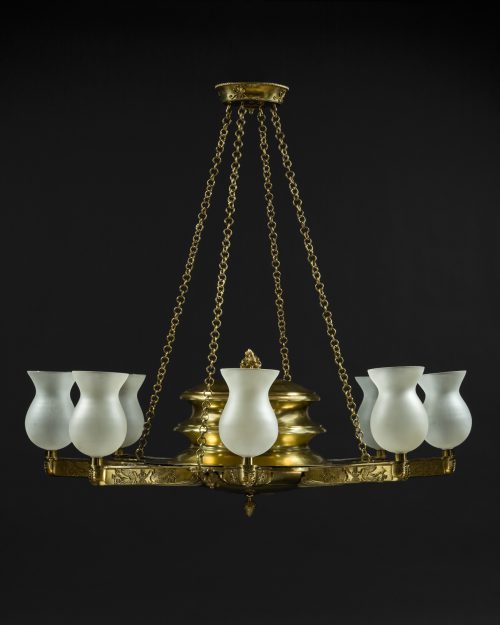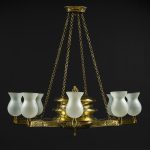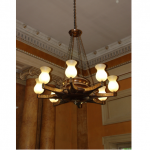9790 THE DOWNING COLLEGE CHANDELIERS A PAIR OF MONUMENTAL GILT-BRONZE CHANDELIERS BY PETER BICKNELL English. Circa 1965. Measurements: Diameter: 6′ (183 cm); Height: approx. 6′ (183 cm)

-
Figure 1
Research
Of gilt bronze. Each suspended by four ring pattern gilt-bronze chains from a corona applied with gilt bronze anthemions, the eight arms also applied with gilt-bronze swan mounts and fronted by gilt-bronze anthemion mounts, terminating in opaque white glass urn-form storm shades, issuing from a central urn-form reservoir topped by a flame-form finial and terminating in an inverted knop. Re-gilded.
Provenance:
Designed by Peter Bicknell for the Dining Hall at Downing College, Cambridge circa mid-1960s.
The present chandeliers were designed by architect Peter Bicknell (1907-1995) and were originally installed in the Hall at Downing College, Cambridge, during a remodeling in the 1960s.
In addition to his career as an architect, Bicknell was a mountaineer, author, curator and teacher of architecture and art history during his lifetime. After his retirement from teaching in 1981, he mounted the exhibition Beauty, Horror and Immensity at the Fitzwilliam Museum, Cambridge. An architectural partnership with H.C. Hughes, which began in the early 1930s, led to the design of numerous educational institutions, notably the Cambridge colleges including Downing College at which Bicknell was a Fellow.
Downing college was founded in 1800 by Sir George Downing, Third Baronet, whose will stated that his estates were to be used for a college if he or his heirs produced no issue. The first buildings were raised between 1807-1812, and the second group in 1818-1820, which included the Hall. Designed by William Wilkins, the neoclassical architecture comprises ionic columns, both inside and out, and was greatly informed by Wilkins’ travels in Greece.
The chandeliers are an interesting exercise in the fusion of English late classicism, as typified as the Regency style, and mid-20th century modernity. The classical references include a flaming urn, repeating anthemion decoration and applied with swan mounts. Whilst incorporating many of these elements of the classical repertoire, the chandelier is also imbued by a severe and angular quality of the time.
Figure 1 depicts one of the chandeliers in situ in the Downing College Hall. The chandeliers were removed from the Hall in 2007 as part of a renovation project aimed at “restoring it to its original Georgian splendour.”1
Footnotes:
1. “A Short College Architectural History.” Downing College. Web. 01 Aug. 2011. <http://www.dow.cam.ac.uk/dow_server/info/College_history.html>


Comments are closed.